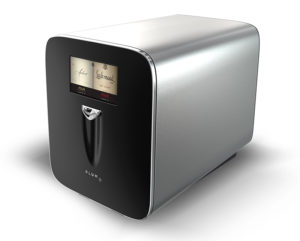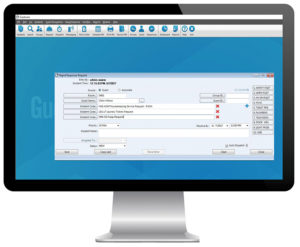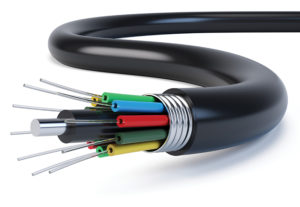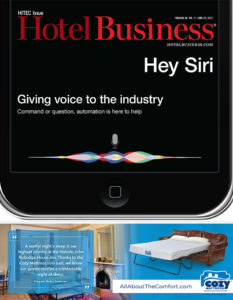Whether hotels want to implement guest-facing technologies that provide expanded amenities and services to guests, or new back-of-house solutions that create cost and labor efficiencies, the infrastructure of the hotel is the foundation on which all other technology depends.
But more than that, all areas of a hotel’s technology lineup have to be integrated, able to work together seamlessly. Back-of-house tools power front-of-house tools, and guests send requests—through various methods—that hotel operators need to be able to act on quickly. And, if there’s a breakdown in the system, or a slow or spotty network connection, none of it works. Of course, the ever-growing need for more bandwidth and better connections to power guest-facing technology and ever-increasing guest devices also feeds into the need for better infrastructure—it’s a delicate ecosystem that hotels need to navigate.
And, certainly, that ecosystem is changing, especially as IoT-connected devices become the norm in hotels. Fred Reeder, president, Nomadix, noted, “There’s a clear increase in not only use of that network but in bandwidth demand.” However, he said, bandwidth demand is not really driven by IoT-devices, which don’t tend to use a lot of bandwidth. They do, however, add more devices to the network—something operators need to think about when they plan out their network architecture.
“The trend in the increase in bandwidth consumption has more to do with how guests tend to use the network and how they use the internet,” he explained. “When you look at the increase in video applications and the use of video across the internet, not only for computing devices such as tablets and laptops, but also the desire to use over-the-top services, as well as the increase in gaming, those are all trends that increase tremendously the bandwidth demand. Those are huge considerations for hotels.”
And, as these changes occur, hotels have to keep up with the times, making sure that the technology solutions they choose are easy to use—and that goes for platforms geared toward guests and employees alike. Alexander Shashou, co-founder/president, Alice, noted, “User experience is ultimately one of the most important things about technology. For it to really work and provide value, the user has to be enjoying the experience and able to use it in a way that facilitates them to do better.”
So just what kind of solutions are technology providers implementing and hoteliers looking for? Read on.
GUEST-FACING

Guests want technology solutions that can upgrade the overall experience—like Plum’s in-room wine dispenser.
Robots. Artificial intelligence. Automation. Casting solutions. Diversified TV offerings. Mobile apps and SMS systems that enable guests to engage with hotels the way they want to. There’s a lot of innovation going on in the guest-facing space—some of which will pan out and some of which won’t. But guest-facing solutions touch all parts of the hotel.
Mark Jarman, Guestware’s president, noted, “There’s really been, over the last five years, an explosion with guest-facing solutions in the industry, and different things from mobile apps where you can chat with the hotel, to being able to do text messaging with the hotel. But we’re hearing hoteliers say they don’t think that anything on the market is really what hotel guests are looking for. Guests do want to interact with the hotel on their smartphone, but what’s out there right now is not ideal. So we’re spending a lot of time doing research in that area, trying to nail the guest-facing tools and making sure it’s seamlessly integrated with the back of the house.”
Whatever the guest-facing solution is, it can’t be so complicated that guests can’t figure it out. David Goldstone, DigiValet’s president, the Americas, noted that when his company designs products, it keeps the users in mind. “You’ve got guests of all age groups using technology. A 70-year-old guest has got to be able to use it as simply as your millennial who has grown up with technology,” he said.
And, sometimes, that means hotels shouldn’t be looking to build or buy their own technology, but should partner with the online and mobile solutions guests already use. Much like many hotel brands partnered with Uber, sometimes even integrating the ride-hailing service into loyalty apps, and in keeping with the Bring-Your-Own-Content trend, Hawthorn Suites by Wyndham decided to expand its extended-stay offering by partnering with both Instacart, a fast-growing retail delivery service, and Peapod, the country’s leading online grocer. Piloting in eight properties, guests at the test hotels can easily find and order all of the ingredients for their favorite Homemade @ Hawthorn recipe, or their most-wanted grocery items, and have them delivered straight to their hotel.
Larry Hambro, VP, brand operations, Hawthorn Suites by Wyndham, said that partnering with established online operators adds to the guest experience. “When you’re traveling for long stretches, you long for home comforts, a regular routine and the services you use in your everyday life,” he said. “For those travelers who already order their groceries online at home through Peapod or Instacart, our new service not only makes their hotel stays feel more homey, but it’s also incredibly easy and convenient for them—they know how the technology works, they can use their existing accounts, and they can have their favorite snacks, staples, and home-cooked meals at their fingertips, even if they’re temporarily situated in a new town.”
Another trend in guest-facing technology? Personalized and upgraded experiences. Much like hotels are turning to concierge apps to help augment the guest’s stay outside the room, many are finding ways to upgrade the stay in-room. For instance, properties like the Four Seasons in Palo Alto, CA; The Confidante in Miami Beach and The Rosewood Sand Hill in Menlo Park, CA, are turning to solutions like in-room wine dispensers.
David Koretz, CEO of Plum, said, “For hoteliers, especially those managing luxury and upper-upscale properties, their primary differentiator is guest experience, and yet these guests are living in an on-demand world. They can get dinner, a car service or groceries at a touch. Unfortunately, guests can get UberEats delivered to their hotel room door faster in most major cities than a hotel’s own room service product. The advancements happening in mobile applications are going to put increased pressure on hoteliers to figure out how to deliver on-demand experiences.”
He added that the company’s wine dispensers “provide a new in-room profit center and can also significantly improve hotel operations by virtualizing amenity programs, performing real-time services recovery, and even personalizing weddings and corporate events.” But, more than that, the solution “enables hoteliers to deliver personalized service to each guest.”
BACK-OF-HOUSE

Hotels need solutions that help employees streamline operations and maximize efficiency—like Guestware’s reporting tool (left) and Beekeeper’s chatbot-enabled survey.
With guest-facing technology getting more complicated, hotels have to have the operational tools to back that up—otherwise, they open themselves up to gaps in the guest experience. And while having a robust system is key, hotels are also looking to add features that do what back-of-house tech does best: streamline operations, saving hotels on labor, costs and time.
“As guest-facing applications are being adopted more and more, if you don’t have a really good management plan and infrastructure in place for the back of the house, you can really set up expectations for guests that you don’t deliver on, which is almost worse than if you didn’t have any guest-facing application at all,” said Marc Jarman, president, Guestware.
And, he noted, one of the things hoteliers are most looking for is the ability to automate as much as possible. “Hotel owners want to keep payroll down, so a lot of the things we’re adding to our rapid response application is to be able to enable the hotel to set up more automated rules to do service delivery, making sure everything is seamlessly integrated,” he said, noting the company recently implemented the ability to trigger different service requests based upon information on the reservation and events like check-in and checkout. “It enables more automation, so the front desk doesn’t have to do as much. The staff can focus their energy on being personable and interacting with the guest, not having to spend a lot of time doing busy work,” he said.
Certainly, that was also the idea behind Alice’s logbooks and package management tool. Alexander Shashou, co-founder/president, noted that guests are treating hotels more like a home—and that includes sending packages. “It’s sometimes cheaper to send your luggage ahead of time than to take it through the airport,” he said, noting that conference-goers, meeting planners and attendees also have a lot that needs to be shipped.
Shashou noted that unlike requests like dinner reservations, which have a defined time, hotels don’t know when guests will pick up packages. “This creates a poor user experience,” he said, noting the tool enables employees to log packages and tracking numbers, share package information across applicable departments and record guest signatures. If a guest receives multiple packages, employees can also record them all without creating separate tickets for each, which helps save time.
Noah Lemaich, director of brand standards, SIXTY Hotels, added that hotels are going to get packages sent, especially if they cater to international travelers. But just as much as it’s a tool to help employees be efficient, it also aids guest satisfaction. “We live in such an instant notification world where they’re going to get a push notification from Amazon within five minutes of that package being signed—we also need to be that much on our toes, too,” he said.
Another trend in back-of-house tools? Artificial intelligence (AI). While a lot of focus is on how AI can be incorporated into guest-facing tools, there are back-of-house uses as well. For instance, Beekeeper added an intelligent chatbot to its employee communication app to facilitate employee surveys. Users interact with the survey in a conversational style that the company says creates a feeling similar to that of texting with a friend.
Flavio Pfaffhauser, Beekeeper’s CTO, noted that this is just the beginning of chatbots in back-of-house technology. “Survey is one thing we run over chatbots, but there’s many more possibilities with chatbots from more HR-oriented things, operational processes and internal communications. For HR, for example, we’re really excited that one of our clients, a pizza delivery company, started to send payroll by Beekeeper to employees. All hourly employees receive their monthly payroll right in their inbox from a chatbot. This saves a lot of time on the HR side.”
INFRASTRUCTURE

Having the proper solutions and equipment means hotels have the robust networks employees and guests require.
All technology depends on the infrastructure of the hotel, so it’s no wonder that upgrading internet and cellular solutions are a priority.
“Internet access is a utility—it’s not an amenity,” said Fred Reeder, president, Nomadix, likening it to heat, water or electricity. “Hotel brands have gone through a process of streamlining the number of service providers. They’re trying to create an environment where it’s still economically viable for a select few service providers because they get the volume of hotels, yet they’re able to deliver the required service.”
Of course, there are ways to improve a hotel’s infrastructure. Larry Birnbaum, VP commercial solutions, VT Group, noted, “Going forward hoteliers will be smart to deploy high bandwidth, fiber optic converged systems that provide internet as a utility, which supports current and future application requirements.”
“With single-mode fiber, you have an infrastructure that will last a minimum of 25 years and it can deliver bandwidth needed, so there won’t be a requirement to change it out,” said Rich Labonski, enterprise sales executive, DASAN Zhone Solutions Inc., noting that it’s more cost effective. “We have seen increased adoption, and that is primarily to deal with increasing demands for bandwidth. We’ve probably doubled in half a year the number of hotel installations compared to all of last year.”
“Because of security requirements, you still see two separate ISP connections to the property for the back-of-house connection and the guest access network,” Reeder said. “Some hotels that are using tablets for housekeeping or using some other IoT-connected devices in the room tend to unify the networks some and use virtual separation through technological VPNs; that’s becoming more widespread.”
Birnbaum agreed. “For security reasons, this is a relatively new deployment in hotels. With device casting/pairing of content, and some IoT devices, personal area networking [PAN] is required to share content and communications between devices in the guestroom.”
Labonski noted that since guests “can access that network anywhere through the hotel,” it opens the hotel up to provide even more services and experiences for the guest throughout the property.
WiFi isn’t the only aspect evolving—cellular coverage is, too. “Cellular is getting to be a bigger issue for hotels,” Birnbaum said. “Coverage can no longer be considered a carrier issue.” Implementation costs are shifting from the carriers to the hotels themselves. “We see it as a great opportunity in that space,” said Richard Grimes, co-founder of Strategic Venue Partners Inc., noting that it enables hotels to differentiate themselves from the competition.
“Every resort is looking for events and groups because that’s where they really drive their revenue. How do we create differentiation to achieve that?” he asked, noting that a strong network at the property does the trick. “A robust, multi-carrier, multi-technology system is able to create that wonderful experience. Over time, that is going to be—depending on the priority and the focus of other resorts and hotels—a requirement. It translates into a real revenue differential of being able to attract people to hotels and resorts.”
He also noted one change occurring in the industry is a shift from “90% equipment, 10% software to probably 10% equipment outside of your backbone and 90% software.” He said this will make upgrades easier, as well as be a space saver.
According to Reeder, one thing to keep an eye on for the future is 5G, which has a high throughput, pointing to two possibilities: Either hotels will use it to boost the back hall, while using WiFi within the property, or subscribers in the cellular network could have 5G connectivity, negating the need for the WiFi network. “The pricing that cellular service providers give their subscribers will determine that,” he said, noting he foresees the former option. “I think there will still be a demand for WiFi, especially when you start casting movies to the TV, etc.”
And that’s a good thing. “The minute you let the cellular providers control the full user experience, there’s a measure of control the operators lose over guests, which can be something very valuable to operators and brands,” he said.

